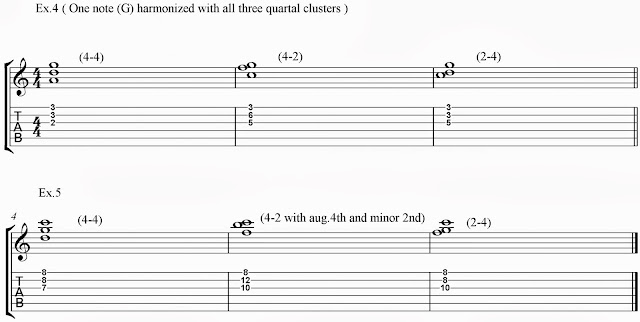For the sake of practice, we will start by limiting ourselves to 3 things:
1.) Notes of the C major scale on the 1st string. These will be designated for melody
2.) The 3 quartal harmony cluster shapes in PART 1 (with slight alterations, where necessary, to maintain diatonic consistency)
3.) The first 3 adjacent strings on the guitar (1st, 2nd, and 3rd) in standard tuning.
For referencing, here are our scale/melody notes to be harmonized: A C major scale on the 1st string.
Take a look at Ex.1 and notice how our first melody note (the top note of the cluster) in the series to be harmonized is going to be the note F on the first fret. Play through these and get them under your fingers and in your ears before moving on to the next example. Notice the clusters marked altered. That is because the tones F and B in the C major scale are an augmented 4th interval apart, as opposed to the perfect 4th interval, thus altering the shape and character of the cluster voicing.
In Ex. 2 below, we are going to use the 4-2 cluster to harmonize our scale/melody tones with the scale/melody tone at the top of the cluster. Again, notice the altered cluster voicings. Because we are using an interval combination of 4ths and 2nds (4-2), and for diatonic consistency, we are going to have some clusters that have a minor 2nd interval (between E and F) in addition to the augmented 4th (between F and B) that we saw in Ex. 1. Get these under your fingers and in your ears as you did with the 4-4 cluster harmonies in Ex. 1.
Ex.3 harmonizes the same scale/melody tones (top tone of cluster) with clusters consisting of a 2nd and a 4th (2-4) from lowest to highest. Again, notice the clusters labeled altered that contain the minor 2nd and augmented 4th intervals.
Another way of perceiving this material is to look at one scale/melody tone and harmonize it with all three quartal cluster voicings shown in Ex. 4 and Ex.5 below. Sing the top tone and play through each harmonization.
Now that we have some familiarity with the scale tones, cluster shapes, and options for harmonizing from the above examples, let's look at some examples of how we can take a melody and harmonize it in a couple different ways by using that material.
Just like in harmonizing Melody With Chords PART 1 , we are going to use this short melodic phrase in Ex. 6 as our guinea pig . Play this phrase, sing it, and get it in your ear. In Ex. 7, the phrase is harmonized using only the 4-4 clusters. In Ex.8, only the 4-2 clusters are used . For Ex.9, only the 2-4 cluster is used. Ex.10 shows a combination of all three cluster voicings.
Sound cool? How about trying your own?
Here's your assignment: Write a melody in the key of C major. Try using different combinations of all three quartal cluster voicings to harmonize your melody.
Note: To make it even more interesting, record a low drone using one of the tones from the C major scale on a loop pedal or your computer and play through your harmonizations over the drone. This is an effective way to practice modal composition/improvisation using quartal harmony. For example, if you use melody/quartal harmony that is diatonic to the C major scale using a "D" drone, you will be evoking the tonality of the "D" Dorian mode, a C major scale with the tone "D'' acting as the new tonal center.





































